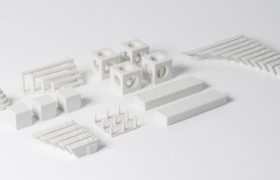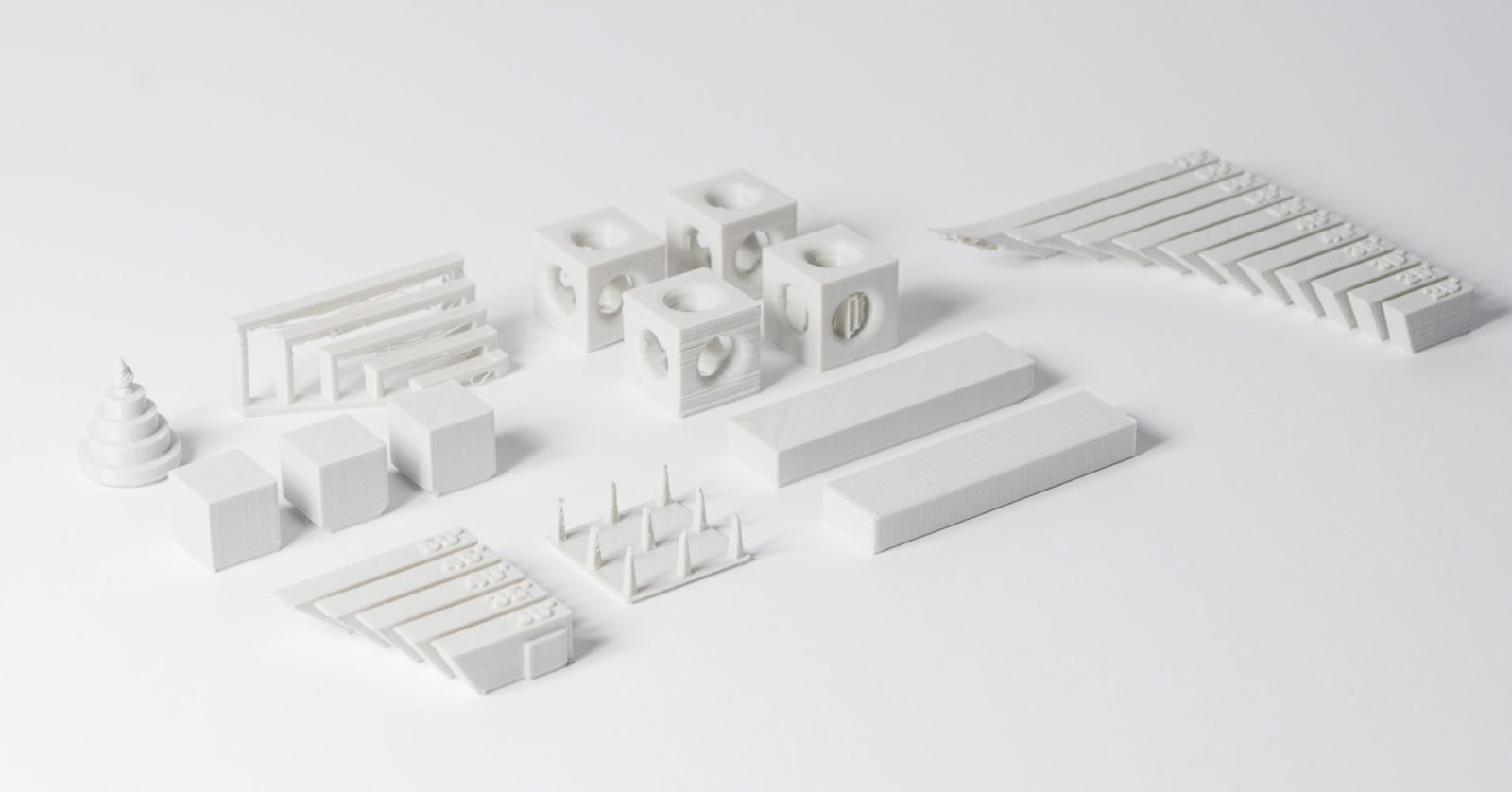
Introduction
As the most affordable 3D Printing technology on the market, Fused Deposition Modelling (FDM) is a great choice for quick and low-cost prototyping that can be used for a wide variety of applications. It can also be a suitable solution for functional parts, such as enclosures.
Like all manufacturing methods, FDM has some limitations and constraints on what can be printed. This article introduces these limitations and discusses methods that can be implemented at the design stage to limit their impact on the quality of a print.
Bridging
Bridging in FDM occurs when the printer is required to print between two supports or anchor points. Because there is no support offered for the initial layer being printed (there is nothing to build upon) and it is required to “bridge” a gap, the material will tend to sag. Bridges occur most often in horizontal axis holes found in the walls of objects or in the top layer (or roof) of hollow parts.
One solution to reduce the impact of bridging is to reduce the distance of the bridge, but this will depend upon the design constraints of the part. Another solution to avoid sagging is to include support. Support offers a temporary build platform for the bridging layer to be built upon. The support material is then removed once the print has been completed. This can leave marks or damage on the surface where the support was connected to the final part.

Key design consideration: Due to the nature of FDM, sagging or marks from support material will always be present to some extent unless the bridge is less than 5mm. An advanced solution is to split the design into separate parts or consider some form of post-processing if a level and smooth surface is required.
Vertical axis holes
FDM will often print vertical axis holes undersized. The general process for printing a hole diameter and the reason the reduction in diameter occurs is:
- As the nozzle prints the perimeter of a vertical axis hole, it compresses the newly printed layer down onto the existing build layers to help improve adhesion.
- The compressing force from the nozzle deforms the extruded round layer shape from a circle into a wider and flatter shape (see image below).
- This increases the area of contact with the previously printed layer (improving adhesion) but also increases the width of the extruded segment.
- The result of this is a decrease in the diameter of the hole that is being printed.
This can be an issue particularly when printing small diameter holes where the effect is greater due to the ratio of hole diameter to nozzle diameter.

The amount of undersize will depend on the printer, the slicing software, the size of the hole, and the material. Often, the reduction in diameter of vertical axis holes is accounted for in the slicing program, but accuracy can vary and several test prints may be needed to achieve the desired accuracy. If a high level of accuracy is required, drilling the hole after printing may be required.
Key design consideration: If the diameter of your vertical axis hole is critical, printing it undersized and then drilling the hole to the correct diameter is recommended.
Overhangs
Issues with overhang are one of the most common print quality problems relating to FDM. Overhangs occur when the printed layer of material is only partially supported by the layer below. Similar to bridging, the inadequate support provided by the surface below the build layer can result in poor layer adhesion, bulging or curling.
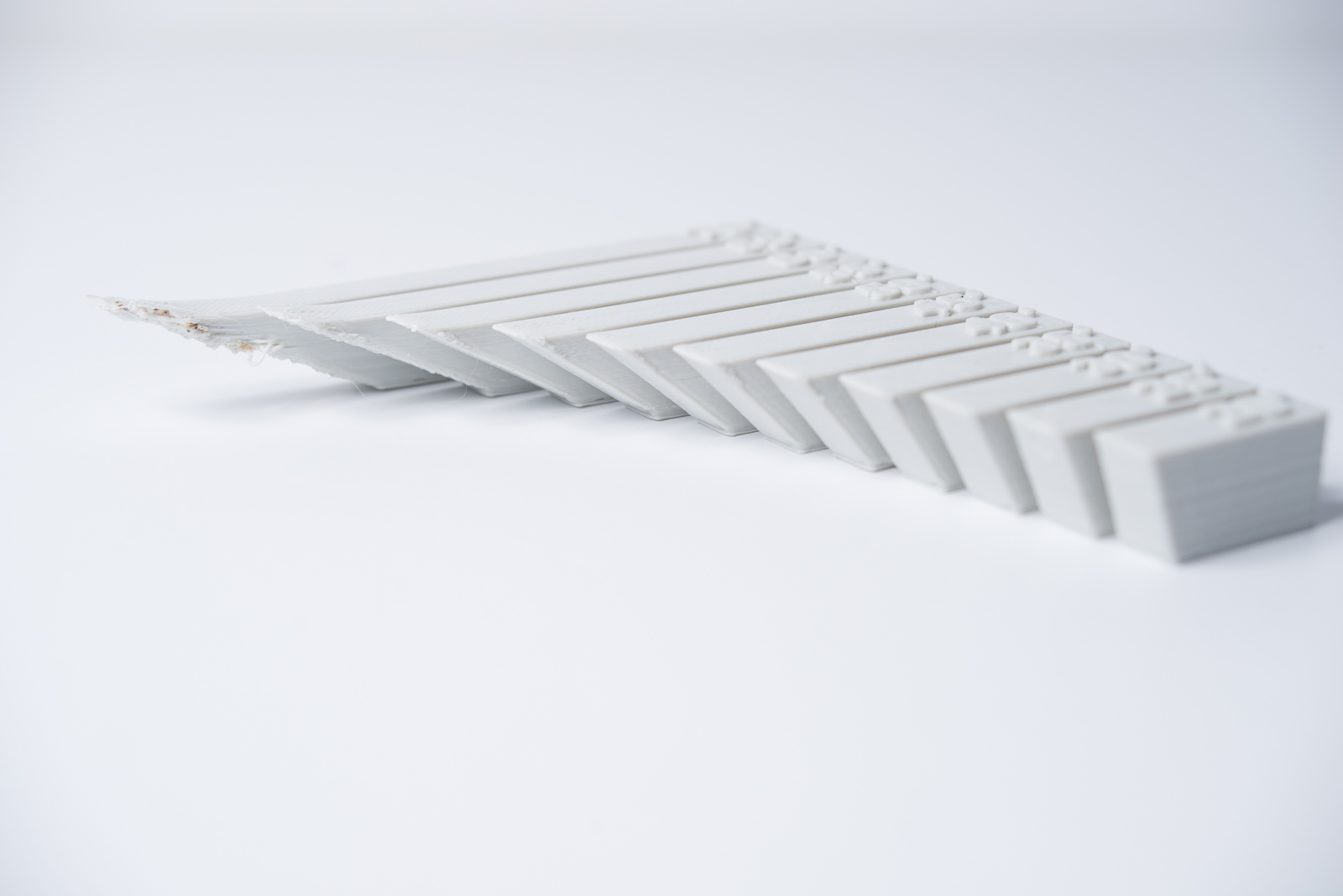
An overhang can usually be printed with no loss of quality up to 45 degrees, depending on the material. At 45 degrees, the newly printed layer is supported by 50% of the previous layer. This allows sufficient support and adhesion to build upon. Above 45 degrees, support is required to ensure that the newly printed layer does not bulge down and away from the nozzle.
Another issue that occurs when printing overhangs is curling. The newly printed layer becomes increasingly thinner at the edge of the overhang, resulting in differential cooling causing it to deform upward (see the image above).
Key design consideration: Limitations on overhangs can be eliminated by the use of support for wall angles above 45 degrees. For larger overhangs where support is needed, marks will be present on the final surface unless post-processed.
Corners
Because the printing nozzle in FDM is circular, corners and edges will have a radius that is equal to the size of the nozzle. This means that these features will never be perfectly square.
For sharp edges and corners, the first layers of a print are particularly important. As discussed above for vertical holes, as the nozzle prints each layer, it compresses the print material down to improve adhesion. For the initial print layer, this creates a flare often called an “elephant’s foot”. This can impact the ability to assemble FDM parts as this flare protrudes outside the specified dimensions.
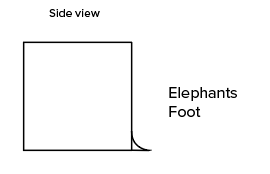
Another issue that is often present relating to the first print layer of an FDM print is warping. ABS is more vulnerable to warping due to its high printing temperature when compared to PLA. The base layer is the first layer to be printed and cools as the other hot layers are printed on top. This causes differential cooling and can result in the base layer curling up and away from the build plate as it shrinks and contracts.
The addition of a chamfer or radius along the edges of the part that is in contact with the build plate will reduce the impact of these problems. This will also assist in the removal of the component from the build plate once the print has been completed.
Key design consideration: If assembly or overall dimensions are critical to the function of an FDM part, include a 45o degree chamfer or radius on all edges touching the build plate. For high precision form & fit testing, other technologies such as SLA or Polyjet are recommended.
Vertical pins
Vertical pins are often printed in FDM when the assembly of parts or alignment is required. Considering that these features are often functional, it is important to understand the size of vertical pins that FDM can print accurately.
Large pins (greater than 5mm diameter) are printed with a perimeter and infill, affording a strong connection to the rest of the print. Smaller diameter pins (less than 5mm diameter) can be made up of only perimeter prints with no infill. This creates a discontinuity between the rest of the print and the pin, resulting in a weak connection that is susceptible to breaking. In a worst-case scenario, small pins may not print at all as there is not enough print material for the newly printed layers to adhere to.
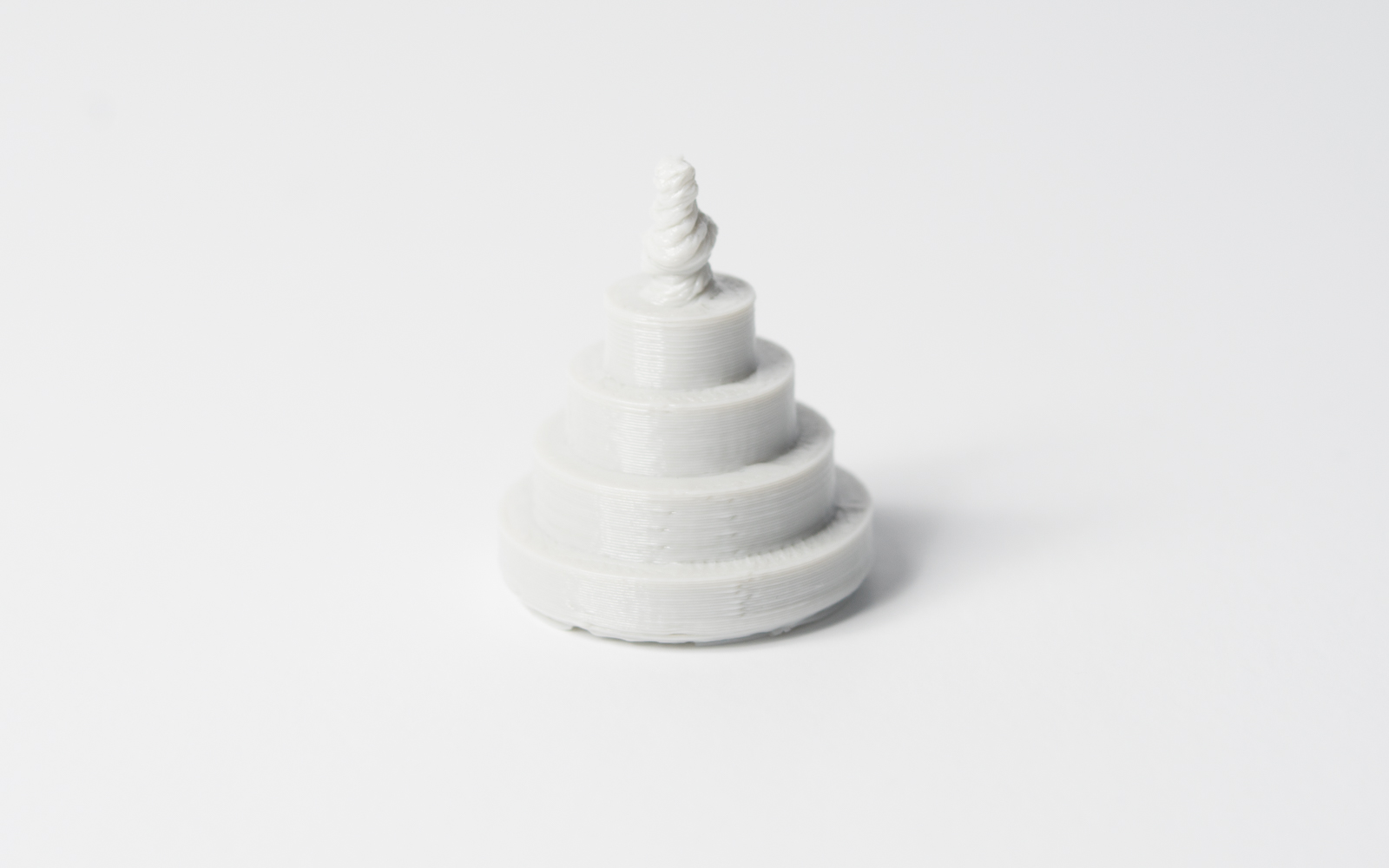
Often correct printer calibration (optimal layer height, print speed, nozzle temperature, etc.) can reduce the likelihood of small pins failing. The addition of a radius at the base of the pin will eliminate that point as a stress concentration and add strength. For critical pins smaller than 5mm diameter, an off-the-shelf pin inserted into a printed hole may be the optimal solution.
Key design consideration: If your design contains pins smaller than 5 mm diameter, add a small fillet at the base of the pin. If the function is critical, consider including a hole in your design in the location of the pin, drill the hole to the correct size and insert an off-the-shelf pin.
Advanced design
Several key aspects to consider when printing with FDM are how to reduce the amount of support required, part orientation and the direction the part is built on the build platform.
Splitting up your model
Often, splitting up a model can reduce its complexity, saving on cost and time. Overhangs that require a large amount of support may be removed by simply splitting a complex shape into sections that are printed individually. If desired, the sections can be glued together once the print has been completed.
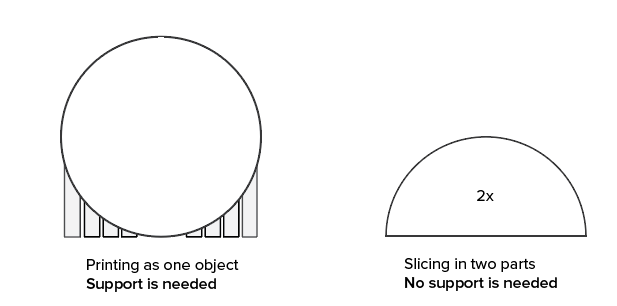
Hole orientation
Support for holes is best avoided by changing the print orientation. Removal of support in horizontal axis holes can often be difficult, but by rotating the build direction 90 degrees, the need for support is eliminated. For components with multiple holes in different directions, prioritize blind holes, then holes with the smallest to largest diameter, then criticality of hole size.

Build direction
Due to the anisotropic nature of FDM printing, understanding the application of a component and how it is built is critical to the success of a design. FDM components are inherently weaker in one direction due to layer orientation.
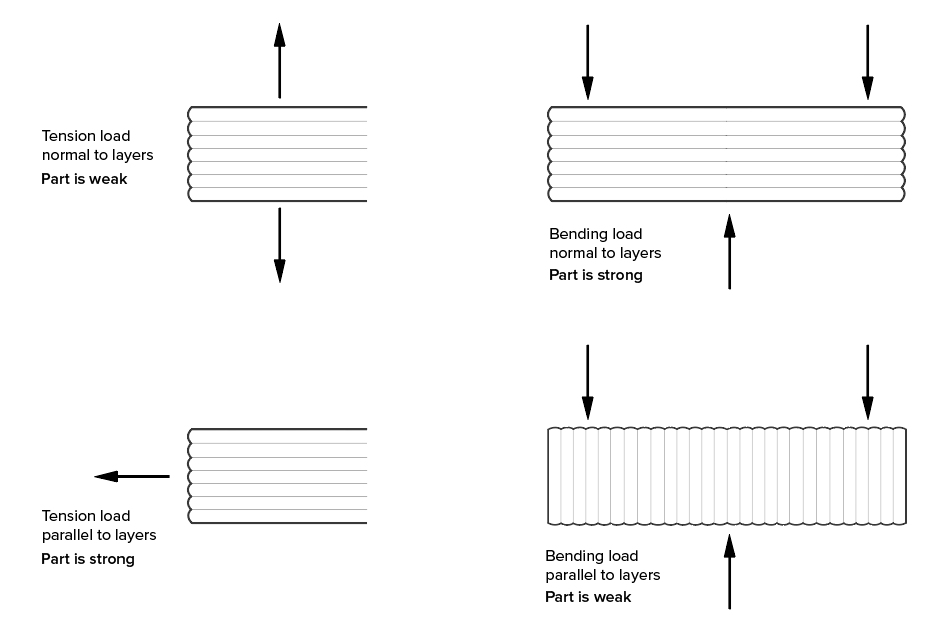
The lack of continuous material paths and the stress concentration created by each layer joint contribute to this weakness. Since the layers are printed as a round-ended rectangle, the joints between each layer are actually small valleys. This creates a stress concentration where a crack will want to form.
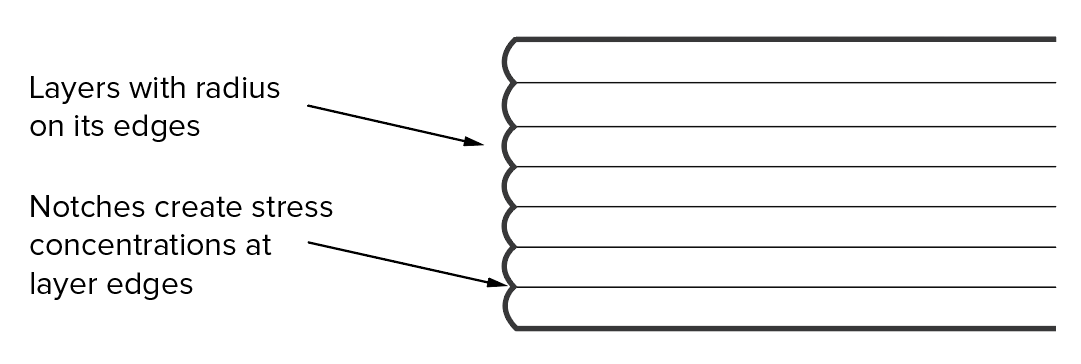
Rules of thumb
- If a bridge exceeds 5mm, sagging or marks from support material can occur. Splitting the design or post-processing can eliminate this issue.
- For critical vertical hole diameters, drilling after printing is recommended if high accuracy is desirable.
- The addition of support will allow FDM printers to print wall angles greater than 45 degrees.
- Include a 45o degree chamfer or radius on all edges of an FDM part touching the build plate.
- For applications with small vertical pins, add a small fillet at the base or consider inserting an off-the-shelf pin into a printed hole instead.
- Splitting a model, re-orientating holes, and specifying build direction are all factors that can lower cost, speed up the printing process, and improve the strength and print quality of a design.
